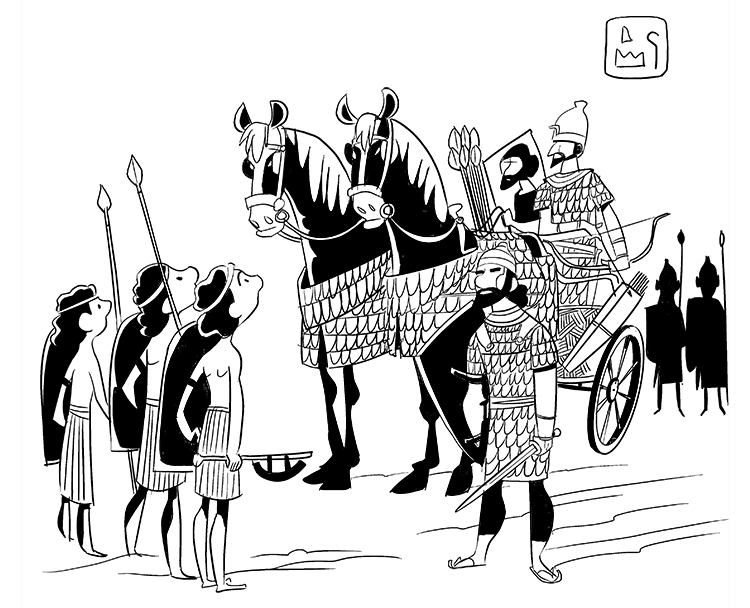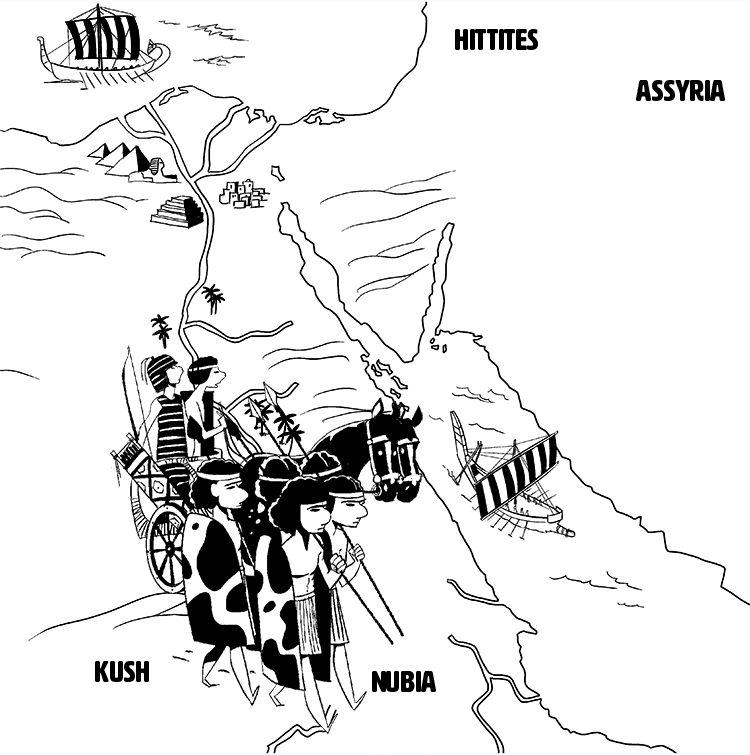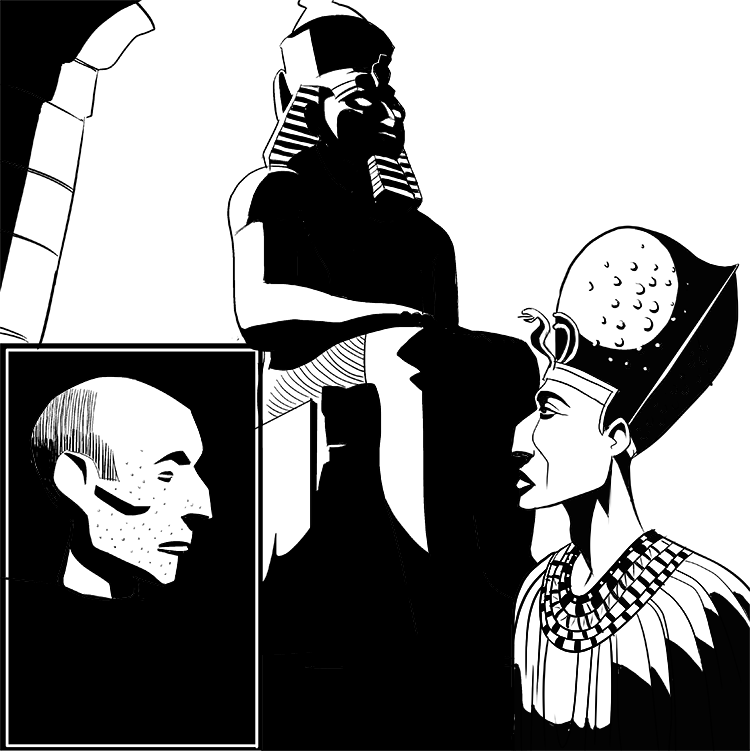The New Kingdom of Ancient Egypt reinstalled Egyptians as the rulers of Egypt after one hundred years of foreign occupation. Because of this time spent under the influence of outsiders, the desire for revenge ran strong.
As a result, the New Kingdom was a period marked by territorial expansion.

Egyptians vs. Hyksos
The Hyksos may have possessed superior war technology such as cavalry, chariots, armor, bronze weapons and the composite bow.
The Rise of the New Kingdom
The Middle Kingdom, based out of Thebes in southern Egypt, fell because no ruler of the 13th dynasty was able to hold power for very long. So, during this time, it was one succession crisis after another. Siblings and cousins fought one another continuously for the right to rule.
This eventually weakened the Egyptian throne to the point where foreigners with superior weapons from Palestine/Syria, namely the Hyksos, were able to settle on Egyptian lands. Eventually, there were enough of them in Egypt to make a successful challenge to the Egyptian throne.
Many of the other cities in Egypt remained independent. But all unity had been lost. Eventually, the Hyksos were able to establish strongholds in the Nile Delta itself, the heart of Egyptian civilization, culture, and power.
After nearly a century of this occupation, Ahmose I became the king of Thebes. He managed to string together enough political alliances, and build a large enough army, to challenge the Hyksos and began removing them from Egyptian territory.
In addition to expelling the Hyksos and restoring Thebes as the capital of Egypt, Ahmose I waged war throughout the Hyksos’ homeland so as to stop them from ever trying to invade again.
Once he succeeded, the New Kingdom was born. But all this time under the influence of foreigners had greatly weakened Egypt and had also damaged its ties and relations with the rest of the ancient world. But from this downtrodden position, Egypt would once again rise to the top of the ancient world.

Expansion
The Egyptians push into Kush, Nubia, Assyria and the land of the Hittites.
Territorial Expansion
After nearly 100 years of political turmoil and foreign occupation, the size of Egypt as a nation was reduced to its smallest point since before the days of the Old Kingdom.
It comes as no surprise then that the rulers of the New Kingdom had conquest on their mind. But before this could happen, Egypt needed some cash. And the way to do this in the ancient world was through war.
Throughout the following century, Egypt continued to expand its boundaries. It did so by first moving south into the kingdoms of Nubia and Kush, which had long been part of the Egyptian empire but had been lost during the Hyksos’ occupation.
Thutmose I, the third ruler of the New Kingdom, campaigned throughout modern-day Iraq and Syria, becoming the first Egyptian ruler to cross the Euphrates River. And his daughter, Queen Hateshput, worked to reestablish Egypt’s long-standing trade networks with the rest of the world.
Many of these trade networks were domestic — between cities located on the Nile — but she also repaired relations with foreign powers.
Since Egypt’s agricultural prosperity meant it always had something to trade, this brought great wealth into Thebes, providing funding for both domestic construction as well as more wars of conquest.

Ramsses The Great
Ramesses The great statue in the Luxor temple (Also known as Ramsses II). Ancient Egyptian embalming techniques and the dry climate of the desert preserved the mummy of Ramesses the Great. (portrait reconstructed from his mummy).
Contact with the Hittites
During the New Kingdom, Egypt expanded to new heights. It’s possible so much focus was given to territorial expansion because of the Hyksos occupation. But no matter the reason, this focus on war helped make Egypt rich and powerful.
The height of the New Kingdom came during the reign of Ramsses II, who is often referred to as Ramsses the Great.
In addition to fortifying Egyptian control throughout Nubia and Kush, he also came into contact with the Hittites, winning several battles and bringing parts of modern day Syria under Egyptian control. Though they were never able to fully conquer the Hittites.
Egypt had never before campaigned in this part of the world, yet another reminder of just how powerful it was under the New Kingdom.
All of this expansion brought unprecedented prosperity to Egypt. But as is the case when a country expands, this success brought new enemies.
After the eventual fall of the New Kingdom, Egypt would become the target of the many rising powers in the region, mainly the Assyrians and the Persians, but eventually the Greeks and finally the Romans.
So, while the New Kingdom may have been the height of Egyptian power, it in many ways also marked the beginning of the end.
The millennium after the fall of the New Kingdom was marked by foregin occupation and political turmoil. But if the New Kingdom was the end, what a way to end things.
The Luxor Temple
Like their predecessors, the rulers of the New Kingdom spent a great deal of time and money building temples and other monuments to showcase their wealth and power.
Perhaps the most significant to come out of the New Kingdom was the Luxor Temple. Started by Queen Hateshput, this temple complex was unique in that it was not dedicated to any one god or group of gods.
Instead, it was a shrine to the kings. It was the site of many coronations and was meant to honor the significance of the pharaoh. In fact, it was during the New Kingdom that Egyptian rulers began taking the title pharaoh.
The construction of the Luxor Temple not only shows the wealth and power of the New Kingdom, but it represents a revitalized nationalism and pride in the king.
Both had likely been considerably damaged during the time of the Hyksos occupation, yet such projects helped reverse this trend and propel Egypt into a new era.

Sea People
In the 8th century BC, tribes known as the Sea People invaded Egypt, weakening its power.
The Fall of the New Kingdom
For as powerful as the New Kingdom was, it came to a rather abrupt halt. In the 8th century BC, tribes known as the Sea People invaded Egypt, weakening its power. But there were other factors at play.
This period of roughly 200 years from 1000 BC-800 BC is known as the Late Bronze Age Collapse. During this time, civilization in Northern Africa and Western Asia all but disappeared. It’s not quite known how this happened, though one theory is that a volcanic eruption sent so much ash into the air that not enough sunlight got through for agriculture to flourish.
This, plus the relentless pressure from invading tribes, brought the New Kingdom, and many other kingdoms in the region, to their knees.
In Egypt, this marked the end of its final period of independent prosperity. But it was an era that helped solidify Egypt’s role as one of the most powerful and influential civilizations of the ancient world.
Written by Matthew Jones
Illustrated by Pablo Velarde Diaz-Pache
